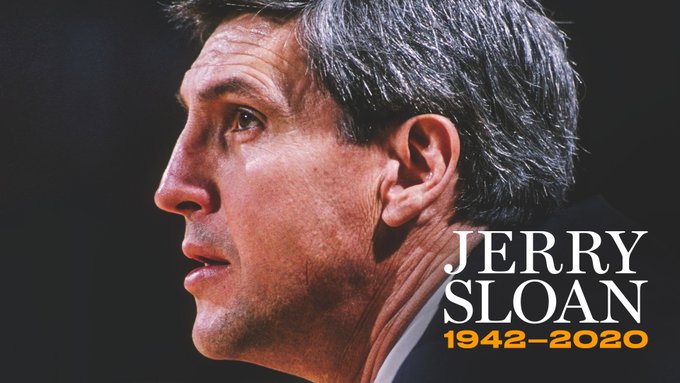
Former Hall-of-Fame coach of the Utah Jazz Jerry Sloan dies at 78, May 22, 2020. /Utah Jazz official Twitter account.
Former Hall-of-Fame coach of the Utah Jazz Jerry Sloan dies at 78, May 22, 2020. /Utah Jazz official Twitter account.
Jerry Sloan, the greatest head coach in Utah Jazz history, died on Friday at age 78 of complications related to Parkinson's disease and Lewy body dementia, which he had been fighting since 2016.
What is your last impression of him?
Was it his serious face during the two NBA Finals series against the Chicago Bulls in the 90s? Was it his old-school Flex offense? Was it the fallout between him and Deron Williams? Was it Sloan's tears in his eyes when he announced his resignation in 2011? Or was it those affecting moments when he came to the Vivint Smart Home Arena to watch Jazz games while battling Parkinson's disease?
Sloan was born in a farm in Gobbler's Knob in Illinois in 1942. His father died when he was 4 years old, leaving him and another nine brothers and sisters for Sloan's mother to raise. He joined the basketball team in high school and spent everyday the same way: waking up at 4 a.m. doing farm chores, walking two miles to school for practice at 7 a.m., and returning home to do more chores until night.
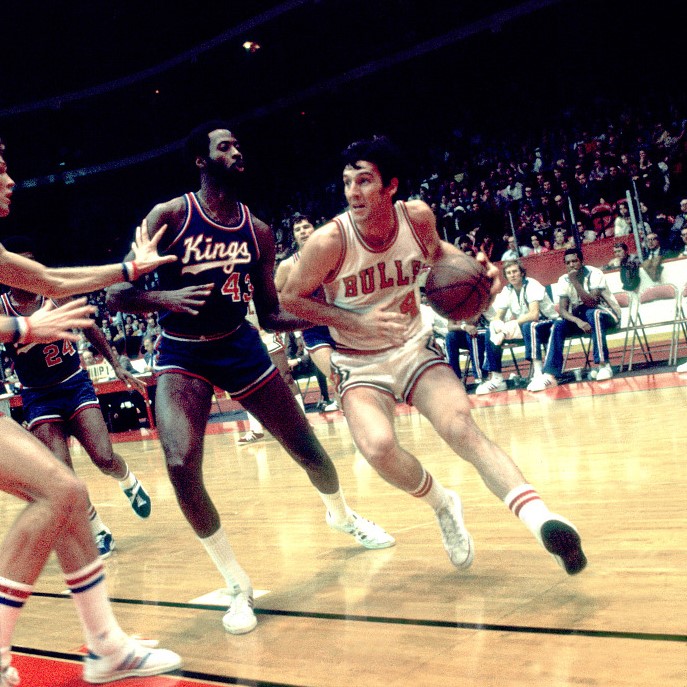
Jerry Sloan of the Chicago Bulls drives towards the rim in the game against the Kansas City Kings at the Chicago Stadium in Chicago, Illinois, 1972. /VCG
Jerry Sloan of the Chicago Bulls drives towards the rim in the game against the Kansas City Kings at the Chicago Stadium in Chicago, Illinois, 1972. /VCG
"It was no picnic," said Sloan. "But we learned that hard work never killed anybody."
Sloan had the chance to enter the NBA in 1964 when the Baltimore Bullets selected him but he chose to stay in college for another year. He only stayed in the Bullets for one year before he was traded to the Bulls, where he continued to play for another 10 years. Though Sloan was only 1.96 meters (6'4") tall, he could cover multiple positions in defense, like he did in college. He knew the defensive secret for small guys like him: try to grab as many as rebounds as possible and work harder than others.
When future Hall of Famer, 2.08-meter-tall (6'8") Willis Reed Jr. of the New York Knicks threatened Sloan "don't get in front of me again," Sloan replied "I ain't afraid of you" after drawing an offensive charge by Reed.
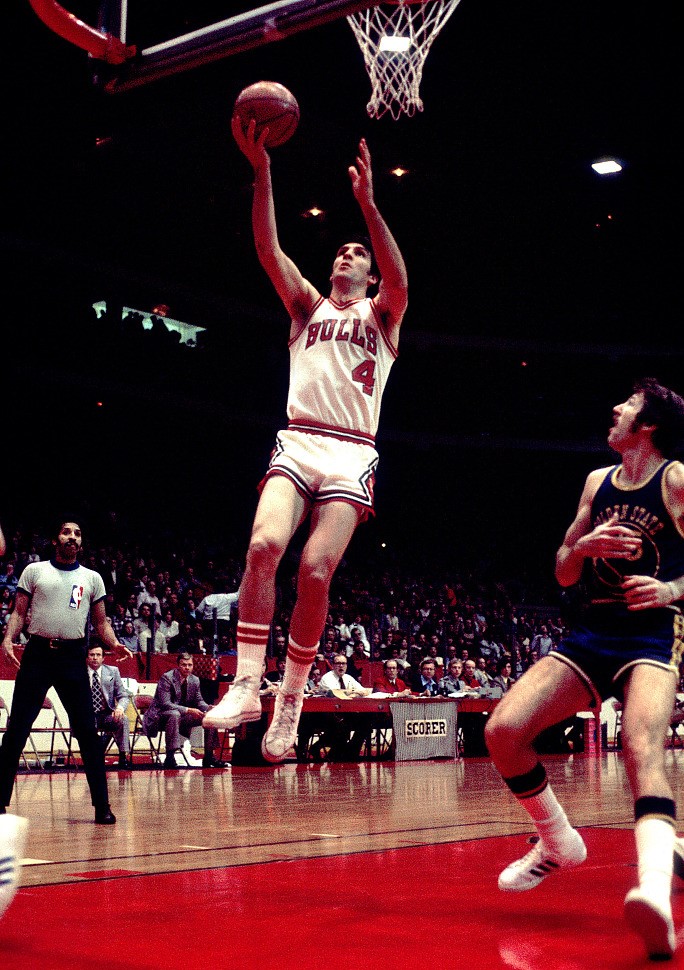
Jerry Sloan of the Chicago Bulls shoots the ball in the game against the Golden State Warriors at the Chicago Stadium, 1972. /VCG
Jerry Sloan of the Chicago Bulls shoots the ball in the game against the Golden State Warriors at the Chicago Stadium, 1972. /VCG
In the 1975 playoffs, the Bulls made the Conference Finals before they lost 4-3 to the Golden State Warriors, which won the championship later led by Rick Barry. As the best small forward at that time, Barry averaged 30.6 points per game in the regular season and he failed to do that in only eight of the 17 playoff games he played. In four of them, he was defended by Sloan.
Thanks to his tenacious defense, Sloan was called "the Gestapo" and "the Human Chain Saw" by his teammates. "He said he never had to feel guilty after a game. He'd go home and sleep like a baby, no matter the outcome. But before a game, he wouldn't go out and shoot. He'd sit in the locker room getting mad at the enemy, which was whoever he was playing that night," said Dick Motta, Bulls head coach back then.
In his 10 years in Chicago, Sloan was named the All-Defensive First Team four times and the Second Team twice. He also played two All-Star Games in which he committed a total of 10 fouls in 40 minutes. In 1978, Sloan's No. 4 jersey was retired by Chicago. He was remembered as "The Original Bull" and the greatest player in franchise history until 1984 when Chicago selected Jordan in the draft.
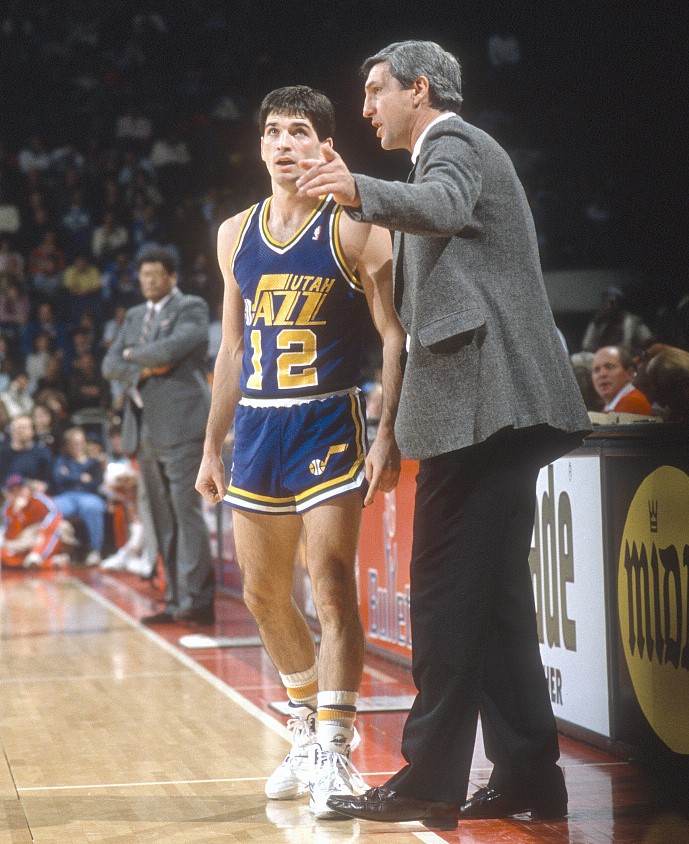
Jerry Sloan (R), head coach of the Utah Jazz, talks to John Stockton in the game against the Washington Bullets at the Capital Centre in Landover, Maryland, 1989. /VCG
Jerry Sloan (R), head coach of the Utah Jazz, talks to John Stockton in the game against the Washington Bullets at the Capital Centre in Landover, Maryland, 1989. /VCG
In 1974, the Jazz joined the NBA and 10 years later they selected John Stockton from Gonzaga University with the 16th pick in the draft. Then in 1985, the team selected Karl Malone from Louisiana Tech with the 13th pick while hiring Sloan as the assistant coach to Frank Layden. In 1988, Layden became Jazz president and Sloan took over as head coach.
In his first nine games, Sloan watched Utah go 3-6 and they were about to meet the Los Angeles Lakers which already won two straight titles. Sloan later admitted that he once thought his coaching career was coming to an end back then.
However, Sloan led the Jazz to defeat the Lakers 101-87 on Christmas. Four months later, the Jazz finished the 1988-89 season 51-31, the first 50-season in franchise history. Both Malone and Stockton were named NBA All-Star for the first time while Malone made the All-NBA First Team for the first time.
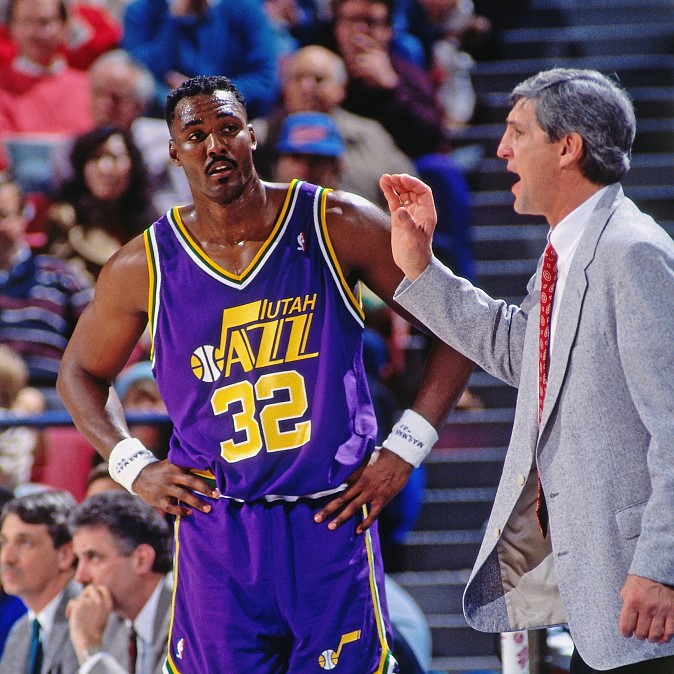
Jerry Sloan (R), head coach of the Utah Jazz, talks to Karl Malone in the game against the Sacramento Kings at the Arco Arena in Sacramento, California, 1991. /VCG
Jerry Sloan (R), head coach of the Utah Jazz, talks to Karl Malone in the game against the Sacramento Kings at the Arco Arena in Sacramento, California, 1991. /VCG
Since then, the Jazz kept making the playoffs and dropped 50-plus wins in four of five seasons. Meanwhile, Malone continued to put down 25+10 while Stockton dominated the assists leader before the two went to the All-Star together. However, that seemed to be the best they could do. Sloan had magic with average players like Mark Eaton but his old-school coaching style could not help the team go further in the playoffs.
Salt Lake City in the 1980s and 1990s was a boring remote city that had no attraction to star players. Some coaches even threatened to send their players there if they don't follow instructions.
The turning point came in 1994 with the arrival of Jeff Hornacek. As a 1.93-meter-tall (6'3") shooting guard, Hornacek was under-average size and possessed no outstanding athleticism. His father was a high school basketball coach who taught him how to pass and shoot and those were probably the only two things Hornacek did well.
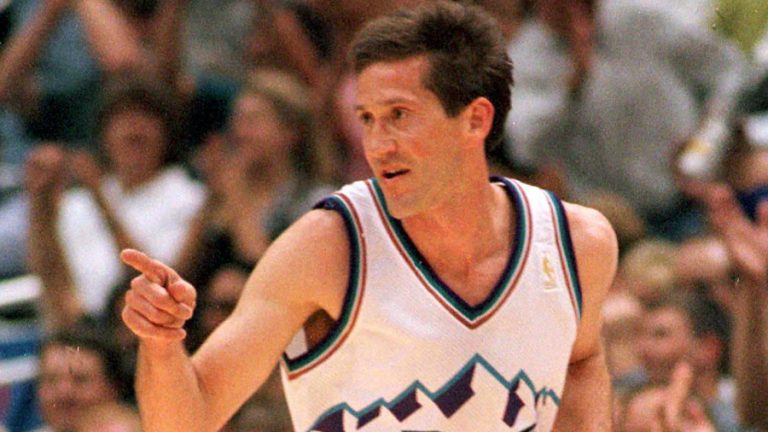
Jeff Hornacek of the Utah Jazz in Game 2 of the Western Conference semifinals against the Los Angeles Lakers at the Delta Center in Salt Lake City, Utah, May 6, 1997. /AFP
Jeff Hornacek of the Utah Jazz in Game 2 of the Western Conference semifinals against the Los Angeles Lakers at the Delta Center in Salt Lake City, Utah, May 6, 1997. /AFP
That's all Sloan and his team needed from him.
Via mysterious chemistry, Hornacek became the game-changer for Utah. In the four seasons from 1995 to 1998, the team reached 60-plus wins in three seasons. The world looked down on them as usual in the 1997 playoffs, especially when they met the Houston Rockets. At that time, Utah's starting-lineup was: 35-year-old Stockton, 33-year-old Malone. 34-year-old Hornacek, the 45th draft select Bryon Russell and the 28th draft select Greg Ostertag. By contrast, Houston had Hakeem Olajuwon, Clyde Drexler and Charles Barkley.
Then in Game 6 of the Western Conference Finals at The Summit, Stockton beat the buzzer to defeat Houston 103-100. Winning 4-2 that series, Utah made the NBA Finals for the first time in franchise history.
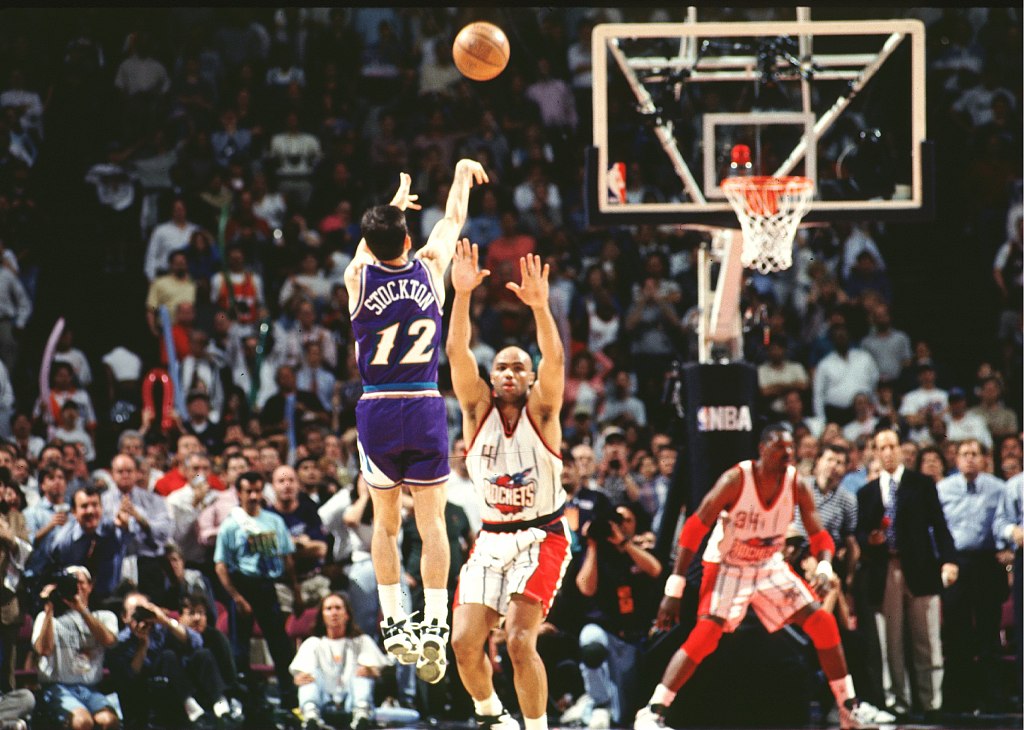
John Stockton #12 of the Utah Jazz beats the buzzer in Game 6 of the Western Conference Finals at The Summit in Houston, Texas, May 29, 1997. /VCG
John Stockton #12 of the Utah Jazz beats the buzzer in Game 6 of the Western Conference Finals at The Summit in Houston, Texas, May 29, 1997. /VCG
We all know what happened in the 1997 and 1998 Finals. Jordan defined the word "greatness" with epic performances with a buzzer beater and "The Flu Game." The 'broken ankle' move Jordan played on Russell to make the game-winning shot at the Delta Center on June 14 was one of the most significant moments in modern sports.
However, please remember who allowed Jordan to continue to create miracles: It was Jerry Sloan, who guided a team of average talents to take down star teams one by one – the Rockets in 1997, the Lakers in 1998 – before driving the greatest NBA player to do his best to defeat them.
Utah's era came to an end after the 1998 Finals loss. The team still made the playoffs but they could not stop the new blood any more, not to mention that their franchise began to fall apart. In 2003, Stockton retired. Malone left for LA to chase a ring.
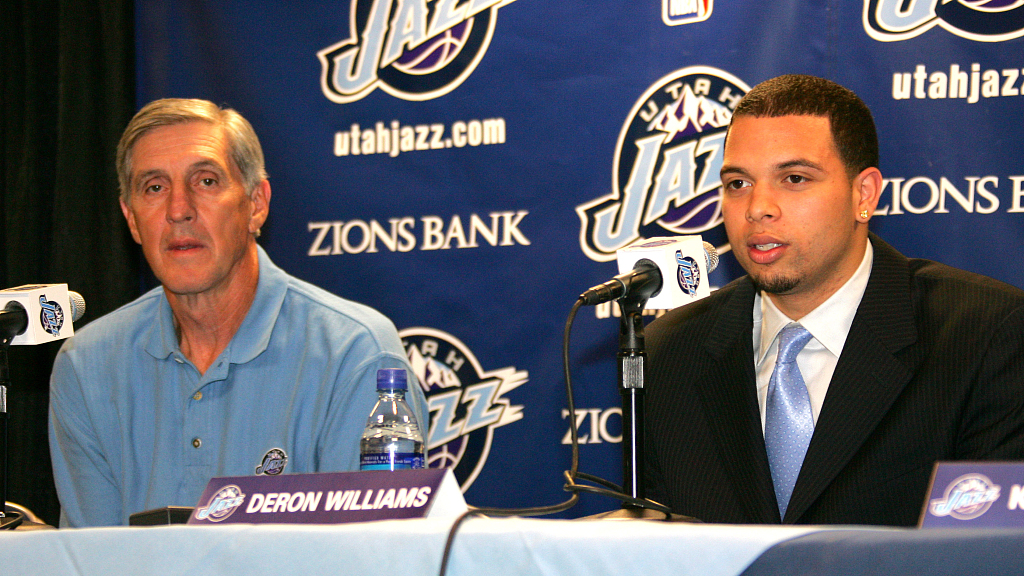
Jerry Sloan (L), head coach of the Utah Jazz, attends a press conference with the team's No. 3 draft select Deron Williams at the Delta Center, June 29, 2005. /VCG
Jerry Sloan (L), head coach of the Utah Jazz, attends a press conference with the team's No. 3 draft select Deron Williams at the Delta Center, June 29, 2005. /VCG
But Sloan stayed. Then in the 2004-2005 season, his team missed the playoffs with a 26-56 record as a result of excessive injuries. The good news was, Sloan received the highest draft pick (No. 3) in his coaching career and he selected Deron Williams from University of Illinois at Urbana–Champaign.
Meanwhile, Sloan continued his old, but effective trick of turning average players into a strong team. Carlos Boozer, Wesley Matthews, Paul Millsap, Mehmet Okur began to impress the league under his guidance. Utah won 51 games in the 2006-07 season and made the Western Conference Finals again.
Nonetheless, something changed. In 2007, Andrei Kirilenko questioned Sloan's system in public. In 2009, Boozer declared he would leave the team. In 2010, Matthews departed for the Portland Trail Blazers. Then there was the act of Williams, which, in the end, led to the worst consequence.
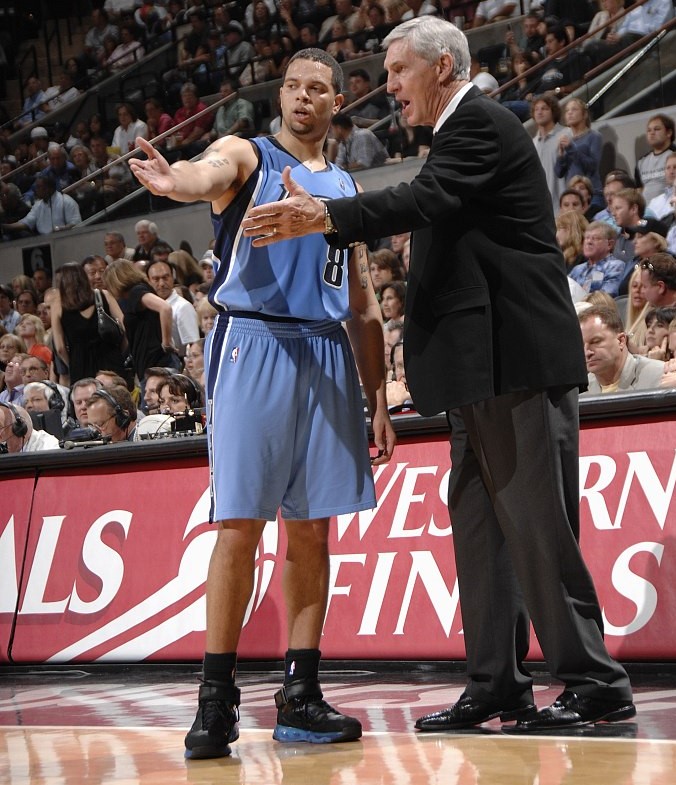
Jerry Sloan (R), head coach of the Utah Jazz, communicates with Deron Williams in Game 2 of the Western Conference Finals against the San Antonio Spurs at the AT&T Center in San Antonio, Texas, May 22, 2007. /VCG
Jerry Sloan (R), head coach of the Utah Jazz, communicates with Deron Williams in Game 2 of the Western Conference Finals against the San Antonio Spurs at the AT&T Center in San Antonio, Texas, May 22, 2007. /VCG
Sloan did not change. He remained extremely strict with his players and never hesitated to criticize them. "He (Sloan)'ll get in our face when he needs to, but when we get it, we know it's because we deserved it," said Stockton. Malone called Sloan "one of the nicest people you'd ever want to meet." Old-school players knew that the coach only wanted the best for them.
However, the 2010s was players' era already. They wanted money, attention and of, course, praise from everybody. Basketball was no longer basketball alone, it's also about business, press, calculation, manipulation. The year 2011 witnessed the departure of Don Nelson, Larry Brown and Sloan. They left with idealism.
Rest in peace, coach Sloan. Never feel guilty after a game.